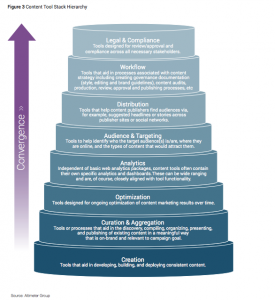
Predictions? Humbug. Never done ’em, never will. As a research analyst, predictions are antithetical to my methodology, which is research followed by analysis. My job is to work with data, information, and pattern recognition to draw informed conclusions — not gaze into a crystal ball.
The scene thus set, let’s look ahead to the new year and what it will bring insofar as content marketing is concerned. Based on my research in the field, I’m seeing seven overall trends in the field that will develop and strengthen in the coming year.
The next big thing in content marketing technology, the content marketing stack, will develop significantly in 2015. Content stacks are necessary to consolidate the eight content marketing use cases identified in research we published on the content software landscape. No use case is an island. As organizations mature and become more strategic in their content marketing initiatives, it becomes imperative to seamlessly link execution to analytics, or optimization, or targeting, for example. We’ll soon see end-to-end offerings from the big enterprise players: Adobe, Oracle, and Salesforce.com. All are scrambling to integrate multiple content point solutions into seamless “stacks,” similar to the ad stack. In fact, content stacks will talk to the ad stacks, helping to integrate paid, owned and earned media. A couple years out, these two stacks will comprise what we refer to today as the marketing cloud.
Culture of content
Content is bigger than just the marketing department. It’s rapidly becoming nearly everyone’s job — and with good reason. Not everyone in marketing is a subject matter expert. Or understands customer service or sales concerns. Or is charged with recruiting new employees. Or develops new products or product features. That expertise and knowledge is embedded deep within the enterprise. Organizations that foster a culture of content by educating and training employees to participate in the content ecosystem can better ideate and create useful, meaningful content at scale that addresses numerous goals and serves a wide variety of internal, and well as external, constituencies. Watch for many more organization to follow the lead of companies, such as Johnson & Johnson, Kraft Foods, and Nestlé. They will train and empower employees, partners, and stakeholders to create, ideate, and leverage content.
Time is a luxury, and will only become more so as brands face the challenges of remaining relevant and topical. Moreover, research indicates real-time campaigns can raise literally all desirable marketing metrics. Success in real-time is grounded in content strategy and often isn’t real-time at all in the literal sense. Instead, it’s meticulous preparation and advance creation of relevant content assets that can be deployed at the appropriate time or moment. Starbucks, for example, has content for warming beverages locked and loaded, so when the snow falls in your town, you’re tempted by that pumpkin latte. Training, assets, preparation, workflow — all these and more are elements of “real-time” marketing.
Social media normalizes
Social media will fade into the background. It’s not that social media is going away. But it’s fading into the background, which is a good thing, because it denotes normalization. “Social” will become just another channel, like search or email (the bright, shiny objects of earlier eras). Social media software vendors will reposition as content marketing purveyors. Their offerings will essentially remain the same, but this new positioning is more topical, and more broadly relevant.
Native standardizes
We define native advertising as a form of converged media that’s comprised of content plus a media buy. Native is surging in popularity, much more quickly than best practices are being established to govern it. This growth will fuel more disclosure, transparency, and policies in 2015 as native becomes much more closely scrutinized by regulators, industry associations, consumers, publishers, and brands.
Rise of context
For most of digital marketing’s relatively short history, personalization has been the ne plus ultra of sophisticated marketing. Addressing the customer by name, knowing their age, gender, date of birth, purchase history — all these data points help marketers deliver messages that are more meaningful and more relevant — and that, by extension, result in higher conversations and deeper loyalty.
Personalization is now being supplanted by technologies that can drive even deeper marketing and experiential relevance. Context’s untapped opportunity is to get an extremely granular understanding of customers, then to anticipate their needs, wants, affinities, and expectations, and develop unique insights to power better marketing across all devices, channels, localities, and brand experiences. Context, in other words, takes not only the “who” into account, but also the when, where, why, and how. Simply put — it’s deeper targeting, and more on-point messaging.
This post originally published on iMedia


